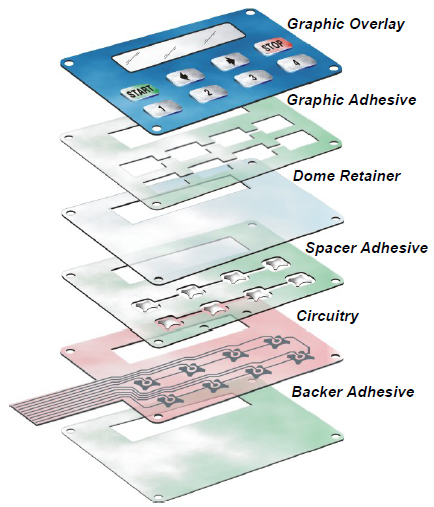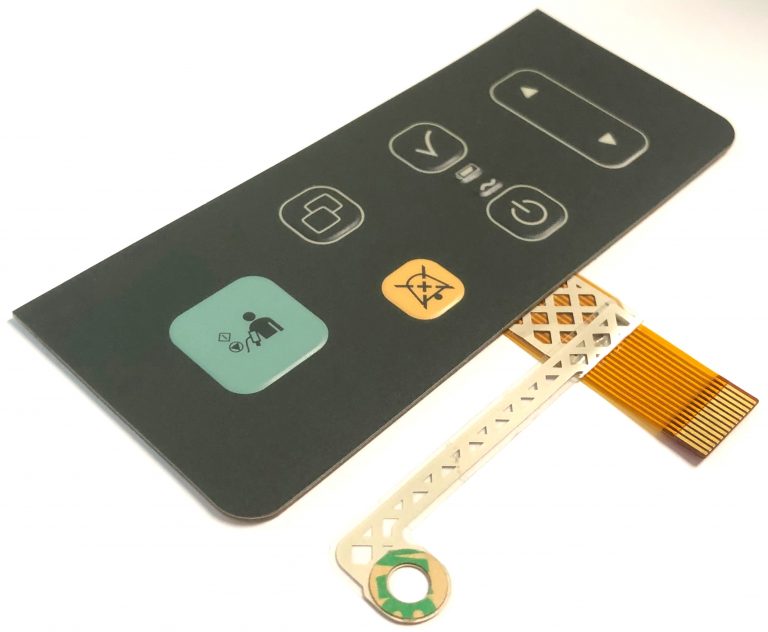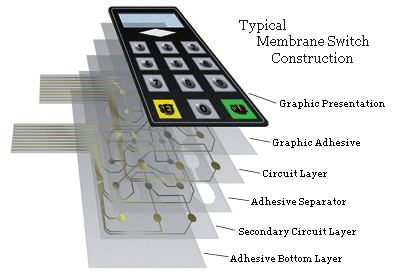Collaborating with an experienced membrane switch manufacturer helps streamline your manufacturing process.
Collaborating with an experienced membrane switch manufacturer helps streamline your manufacturing process.
Blog Article
What to Search for When Choosing a Membrane Change for Your Project
When you're picking a membrane switch for your project, numerous vital aspects enter play. You'll require to think of the materials, style, and just how well it lines up with your brand name. Sturdiness and use are essential, yet so is the reputation of the manufacturer. Understanding these elements can assist you make an informed choice-- one that stabilizes top quality and price successfully. Let's explore what you ought to think about to guarantee your option fulfills all your job needs.
Recognizing Membrane Layer Switch Components
When you plunge into the world of membrane layer buttons, it's vital to comprehend the crucial elements that make them work. Below that, the spacer layer warranties there's adequate distance between the circuit and the overlay, permitting the switch to activate without constant pressure.
Understanding how these layers function with each other assists you pick a membrane button that's dependable and fits your job needs. Pay close focus to the density and material of each layer, as these factors affect toughness and functionality in numerous settings.
Product Choice and Its Influence
Picking the best materials for your membrane button can greatly affect its performance and longevity. The choice of substrate, typically polyester or polycarbonate, affects sturdiness and versatility. Polyester is a lot more abrasion-resistant, while polycarbonate uses better clarity and strength.
Next, take into consideration the adhesive. It needs to endure environmental aspects like moisture and temperature level modifications. A strong adhesive guarantees that your membrane switch remains undamaged gradually.
Don't ignore the graphic overlay. The printing approach made use of, whether silkscreen or digital, influences the button's appearances and longevity. Premium inks will certainly resist fading and scratching, maintaining a professional appearance.
Last but not least, think of ecological conditions. If your tool will be exposed to harsh chemicals or extreme temperatures, select materials designed to endure these difficulties. Your selections in materials will inevitably establish the button's reliability and user complete satisfaction.
Style Considerations for Individual Experience
Selecting the ideal products lays the foundation for an effective membrane layer button, yet the layout additionally plays a substantial duty in individual experience. You'll wish to assess just how the format influences use (membrane switch manufacturer). Maintain buttons and icons intuitive and well-spaced, making it very easy for customers to browse without confusion

Color and contrast are also essential; guarantee that your design is visually enticing yet still practical. High contrast assists users easily identify buttons, specifically in low-light problems.
Lastly, review the overall aesthetic. A streamlined and modern-day design can boost individual understanding and make your item much more enticing. Stabilizing performance with an engaging style will result in a far better customer experience and eventually, a more successful item.

Environmental Elements and Toughness
When choosing a membrane switch, you require to think about exactly how it'll carry out in various environments. Variables like temperature level resistance, wetness and chemical exposure, and mechanical wear can greatly influence its toughness. Recognizing these aspects will aid you pick a switch that withstands your details problems.
Temperature Level Resistance Needs
As ecological conditions can vary commonly, understanding temperature level resistance is essential for making sure the durability of your membrane button. Make sure to inspect the specs of the products made use of in the button, like the glue and overlay, as they directly impact performance. By choosing a membrane layer button with adequate temperature resistance, you'll improve its life expectancy and keep capability in challenging environments.

Wetness and Chemical Exposure
Moisture and chemical exposure can considerably influence the performance and durability of your membrane switch, so it's essential to comprehend the environment in which it will be made use of. If your job entails high humidity or direct exposure to liquids, seek protective coatings and sealers that can enhance resistance to wetness. Furthermore, think about the sorts of chemicals your button might come across. Particular products can weaken when exposed to solvents, oils, or harsh cleaners. Selecting the right materials, like polycarbonate or polyester, can help resist these elements. Always speak with the maker's specs for chemical compatibility to ensure your membrane layer switch preserves its performance in time. By prioritizing dampness additional reading and chemical resistance, you can boost the durability of your button in tough settings.
Mechanical Damage
While you might focus on features like aesthetic appeals and capability in your membrane switch, mechanical wear and tear can considerably influence its performance over time. Frequent pushing can lead to destruction of products, causing issues like tactile responses loss or also change failing. Picking a durable button guarantees longevity and reliability, avoiding pricey substitutes and downtime in your project.
Personalization Options for Branding
When it pertains to branding your membrane layer switch, modification options are essential. You can select style aspects and shades that show your brand name, in addition to specific logo design positioning and dimension to enhance presence. In addition, picking the appropriate products and structures can raise the general feel and look, making your item stick out.
Style Aspects and Colors
A large range of layout aspects and colors can make your membrane layer switch not simply practical but additionally visually enticing, boosting your brand name identity. Do not fail to remember concerning structures; adding a responsive component can enhance user experience and make your switch stand out. By attentively choosing check here layout aspects and shades, you not only produce an item that looks terrific however also strengthens your branding continually and properly.
Logo Positioning and Dimension
After finalizing your style components and colors, the following step is to concentrate on logo design positioning and size. Your logo is a crucial aspect of your branding, so you'll desire it to stick out without overwhelming other style components. Review where your logo design will certainly be most visible and impactful; typical positionings include the top or center of the button.
Don't forget to contemplate exactly how the logo lines up with individual interaction. This interest to detail will certainly improve both performance and brand name identification in your task.
Product and Appearance Alternatives
Picking the appropriate products and textures for your membrane button can substantially boost both its capability and visual allure. You'll want to review alternatives like polyester or polycarbonate, as they supply durability and resistance to put on. The structure of the surface also plays an important role; smooth finishes provide a sleek appearance, while textured surface areas can improve grip and tactile responses.
Tailoring the materials and appearances allows you to mirror your brand name identity efficiently. For example, you may select a matte surface to share sophistication or a glossy look for a modern-day touch - membrane switch manufacturer. Do not ignore shade options, as vibrant tones can make your switch attract attention, while low-key tones can produce a much more elegant look
Expense vs. High Quality: Finding the Right Equilibrium
When you're handling the alternatives for membrane buttons, stabilizing cost and high quality can really feel overwhelming. A lower-cost switch could save you money upfront, yet if it compromises performance, you can face higher substitute expenses later.
Try to find manufacturers that provide an excellent mix of affordability and high requirements. Research their track record and client evaluations to gauge dependability. Sometimes, investing a like it bit extra in quality materials can conserve you from future frustrations.
Also, think about the lasting efficiency and warranty options. A a little much more costly switch with a strong guarantee can confirm to be a smarter financial investment. Inevitably, it has to do with finding that pleasant spot where you meet your budget while ensuring your job's success.
Examining and Quality Control Protocols
While you may locate the perfect membrane layer switch style, ensuring its high quality with extensive testing protocols is important for long-lasting success. Start by confirming that the supplier complies with market standards, such as IPC/WHMA-A -620, to assure a reputable item. membrane switch manufacturer. You'll desire to check for comprehensive testing methods, including environmental, mechanical, and electrical evaluations
Make sure the buttons undertake toughness testing, mimicing real-world usage to recognize any type of prospective failures. Take notice of the supplier's quality guarantee process, which should consist of normal examinations and audits.

Do not forget to request samples and perform your own examinations to confirm compatibility with your job. Consider just how typically the manufacturer updates their procedures; innovation in testing can lead to enhanced top quality. By prioritizing these screening and quality guarantee protocols, you'll boost the likelihood of a successful and durable membrane button for your application.
Frequently Asked Concerns
For how long Does a Membrane Layer Switch Usually Last?
A membrane layer switch usually lasts anywhere from 1 to 10 million cycles, relying on usage and environmental aspects. You'll wish to take into consideration your certain demands to guarantee it satisfies your long life demands properly.
Can Membrane Switches Be Repaired if Damaged?
Yes, you can often repair membrane layer switches if they're damaged, however it commonly depends on the level of the damages. Small issues could be reparable, while extra substantial damage usually requires replacement for correct functionality.
What Are the Usual Applications for Membrane Layer Switches?
Membrane switches are frequently made use of in devices, medical devices, and auto controls. You'll locate them in customer electronic devices, industrial devices, and even video gaming consoles. Their adaptability makes them suitable for various interface and environments.
Are There Specific Certifications for Membrane Switches?
Yes, there specify accreditations for membrane layer switches. Seek UL, CE, and RoHS qualifications to assure safety and conformity. These qualifications suggest the button satisfies industry standards for quality and ecological security.
How Do I Ensure Correct Installment of a Membrane Layer Change?
To assure appropriate setup of a membrane button, clean the surface area completely, align it carefully, and use also stress. Comply with manufacturer standards for sticky curing time to make best use of longevity and functionality.
Conclusion
When selecting a membrane button for your project, maintain these key variables in mind: prioritize long lasting materials, focus on straightforward design, and consider customization for your brand. By meticulously assessing these elements, you'll ensure your membrane switch not only satisfies your task requires yet additionally enhances individual experience and mirrors your brand name identification properly.
Report this page